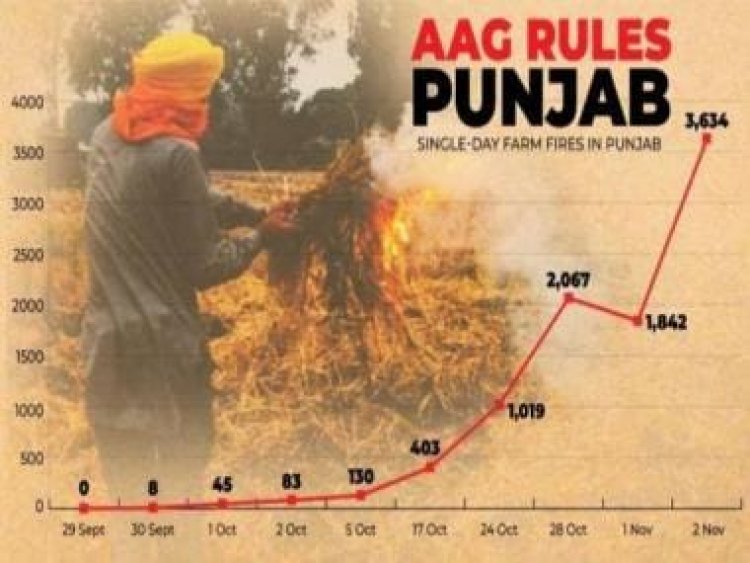FP Analysis: Why parali or stubble burning has choked Delhi-NCR only in the past decade?
FP Analysis: Why parali or stubble burning has choked Delhi-NCR only in the past decade?

New Delhi: As northern India gears up for winter, the thick layer of smog, just like the past few years, have made a comeback in the Delhi-NCR region. The people in the national capital woke up to smoggy morning on Thursday as the air quality has entered ‘severe’ category with overall AQI of 418. With smog comes the usual political blame game among the Delhi, Punjab and the Central government. The pertinent question still remains what is the biggest source of poor air quality in Delhi.
Stubble burning in Punjab ‘single biggest source’ choking Delhi-NCR
Delhi AQI is running at 500-800 range and burning of crop residue is the single biggest source of poor air quality in the national capital.
As per the Economic Survey 2021-2022, a Commission on Air Quality Management in NCR and adjoining areas was promulgated for better co-ordination, research, identification and resolution of problems surrounding the air quality index.
To control emissions from stubble burning, under Central Government Scheme on ‘Promotion of Agricultural Mechanization for in-situ management of Crop Residue in the States of Punjab, Haryana, Uttar Pradesh and NCT of Delhi’.
Agricultural machines and equipment for in-situ crop residue management are promoted with 50 per cent subsidy to the individual farmers and 80 per cent subsidy for establishment of custom hiring centres.
Farmers in Punjab shift kharif crop cycle by three weeks
The satellite images shared in this year’s economic survey illustrated the actual problem behind the stubble burning in Punjab which is weighing on air quality of the neighbouring states.
Farmers in Punjab have shifted their kharif cropping cycle by three weeks. About 15 years ago, the farmers sowed kharif crops by mid-June and harvested them by mid-October after which the land was prepared for rabi sowing by early November.

However, over the past few years, the kharif sowing is continuing till early July because of which the crops are still standing till October end and have to be hurriedly harvested by the beginning of November. This shows that the farmers in Punjab has mere week to clear the land for rabi sowing due to which they resort of crop burning.

Punjab Preservation of Subsoil Act, 2009 prohibits farmers from sowing on time
The government in Punjab introduced the Punjab Subsoil Preservation Act, 2009, to mitigate the complication of the diminishing water table in the state. As per the Act, farmers were prohibited from sowing paddy in nurseries before May 10 and transplanting the seedlings before June 10.
The objective of the Act was to delay the sowing of paddy so that the water used for harvesting these seeds can be reduced.
Before the Act came to force, farmers used to harvest paddy seeds in April. It was found that 4,500 litres of water are required to grow 1 kg of rice when it is sown in April-May. But when the sowing is done in mid-June, water requirement is significantly reduced to 1500-2000 litres.
Punjab farm fires
On Wednesday alone, Punjab clocked 3,634 cases of stubble burning, making it the highest number of farm fire incidents so far this season.
As per the data from Ludhiana-based Punjab Remote Sensing Centre, the cumulative farm fire cases from September 15 to November 2 reached 21,480.
During the same period in 2020 and 2021, Punjab had registered 36,765 and 17,921 farm fire incidents respectively.
Delhi-NCR becoming victim of Punjab stubble burning?
The Air Quality Index (AQI) in Delhi at 8 am was at 364 (in the ‘Very Poor’ category) and at 7 am the recorded AQI stood at 408 (‘Severe’). Along with unfavorable meteorological conditions with slower wind speed and sudden spurt in farm fire incidents have been attributed for the dip in air quality in the national capital.
AQI in Noida, which is part of the national capital region (NCR), slipped to 393, in the ‘very poor’ category, while Gurugram’s AQI stood at 318 and remain in the ‘very poor category.
An AQI range between 0 to 100 is considered to be as as good, while from 100 to 200 it is moderate and from 200 to 300 it is poor. AQI ranging from 300 to 400 it is very poor.
An AQI between 401 and 500 is categorised as severe.
For the first time this season, Delhi’s 24-hour average air quality on Tuesday dipped into ‘severe’ category with an AQI of 424, the Central Pollution Control Board said.
The Arvind Kejriwal-led Delhi government has appealed to people to work from home to reduce vehicular pollution which may make the air more polluted and difficult for breathing.
Read all the Latest News, Trending News, Cricket News, Bollywood News,
India News and Entertainment News here. Follow us on Facebook, Twitter and Instagram.
What's Your Reaction?



























































